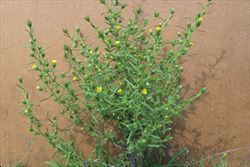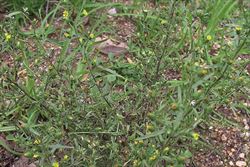Click on images to enlarge

habit (Photo: Trevor James)

habit (Photo: Jackie Miles and Max Campbell)

upper leaves and young flower-heads (Photo: Greg Jordan)

hairy stem and flower-heads (Photo: Trevor James)

close-up of flower-head (Photo: Greg Jordan)

mature flower-head (Photo: Jackie Miles and Max Campbell)

close-up of old flower-heads with seeds (Photo: Jackie Miles and Max Campbell)
Scientific Name
Dittrichia graveolens (L.) Greuter
Synonyms
Erigeron graveolens L.Inula graveolens (L.) Desf.
Family
Asteraceae (Queensland, New South Wales, the ACT, Victoria, Tasmania, Western Australia and the Northern Territory)Compositae (South Australia)
Common Names
camphor inula, Cape khakiweed, stinking fleabane, stink-weed, stinkweed, stinkwort
Origin
This species is native to the southern Europe (i.e. France, Portugal, Spain, Albania, Bulgaria, Greece, Italy and Yugoslavia), northern Africa (i.e. Algeria, Morocco and Tunisia), western Asia and Pakistan.
Naturalised Distribution
This species is widely naturalised in the semi-arid and temperate regions of southern Australia. It is most common in Victoria, south-eastern South Australia, south-western and western Western Australia and the sub-coastal districts of southern and central New South Wales. Less common in other parts of New South Wales and South Australia and present in Tasmania and south-eastern Queensland. Also recorded in the ACT and in the south-western parts of the Northern Territory.
Naturalised overseas in New Zealand and some parts of the USA.
Notes
This species is mainly a weed of agricultural areas and habitation, but it is also regarded as an environmental weed in some parts of Victoria and as a minor environmental weed in Western Australia. It primarily occurs on land subjected to grazing or other disturbance (e.g. roadsides), but also grows along waterways (i.e. in riparian zones), in wetlands and in coastal habitats.
Stinkweed (Dittrichia graveolens) has invaded numerous conservation areas in Victoria (e.g. Phillip Island Nature Park and Rutherglen Nature Conservation Reserve), South Australia (e.g. Cobbler Creek Recreation Park, Hanson Scrub Conservation Park and Coffin Bay National Park), Western Australia (i.e. Cambridge Coastal Reserve) and New South Wales (e.g. Kinchega National Park). It is also noted to be a high threat weed species in spring soak woodlands in north-western Victoria.

